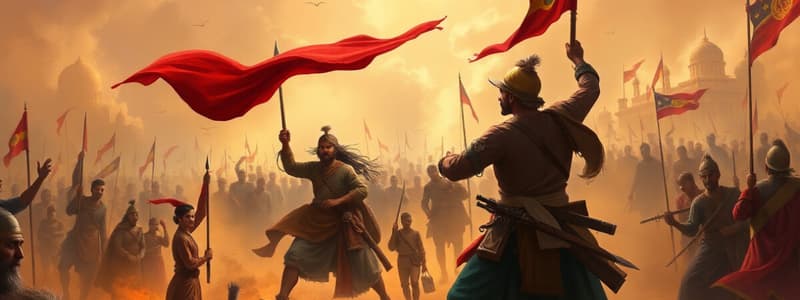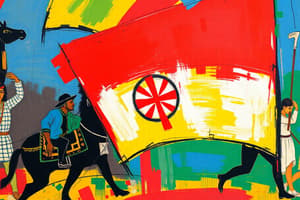Podcast
Questions and Answers
Which of the following figures continued guerrilla warfare against the British after the fall of Jhansi?
Which of the following figures continued guerrilla warfare against the British after the fall of Jhansi?
- Bakht Khan
- Tantia Tope (correct)
- Kunwar Singh
- Ahmadullah Shah
Following the events of 1857, the British Crown relinquished all control over India, granting complete autonomy to local rulers.
Following the events of 1857, the British Crown relinquished all control over India, granting complete autonomy to local rulers.
False (B)
What was the new title given to the Governor-General of India after the British Crown took direct control?
What was the new title given to the Governor-General of India after the British Crown took direct control?
viceroy
After the uprising, the British recruited more soldiers from communities they considered loyal, such as ________, Sikhs and Pathans.
After the uprising, the British recruited more soldiers from communities they considered loyal, such as ________, Sikhs and Pathans.
Match the following locations with the leader who led the uprising there:
Match the following locations with the leader who led the uprising there:
Which British policy most directly led to Rani Lakshmibai of Jhansi losing her kingdom?
Which British policy most directly led to Rani Lakshmibai of Jhansi losing her kingdom?
Governor-General Canning declared in 1856 that Bahadur Shah Zafar would immediately be removed from his position, effectively ending the Mughal dynasty.
Governor-General Canning declared in 1856 that Bahadur Shah Zafar would immediately be removed from his position, effectively ending the Mughal dynasty.
What was the primary reason given by the British for the annexation of Awadh in 1856?
What was the primary reason given by the British for the annexation of Awadh in 1856?
In 1824, sepoys refused to go to __________ by sea, fearing loss of caste.
In 1824, sepoys refused to go to __________ by sea, fearing loss of caste.
What event directly triggered the widespread revolt of 1857 after rising tensions?
What event directly triggered the widespread revolt of 1857 after rising tensions?
Match the following leaders to their actions during the 1857 revolt:
Match the following leaders to their actions during the 1857 revolt:
Why did many rulers and zamindars join the 1857 uprising despite the risks involved?
Why did many rulers and zamindars join the 1857 uprising despite the risks involved?
The British respected the religious beliefs of the sepoys by ensuring that their uniforms and equipment were in accordance with their customs.
The British respected the religious beliefs of the sepoys by ensuring that their uniforms and equipment were in accordance with their customs.
Flashcards
Ahmadullah Shah
Ahmadullah Shah
A maulvi who inspired resistance against the British in Faizabad.
Bakht Khan
Bakht Khan
Took command of rebel forces in Delhi during the 1857 uprising.
Kunwar Singh
Kunwar Singh
Old zamindar who fought fiercely against the British in Bihar.
1858
1858
Signup and view all the flashcards
Gurkhas, Sikhs, and Pathans
Gurkhas, Sikhs, and Pathans
Signup and view all the flashcards
Loss of Autonomy
Loss of Autonomy
Signup and view all the flashcards
Doctrine of Lapse
Doctrine of Lapse
Signup and view all the flashcards
Bahadur Shah Zafar
Bahadur Shah Zafar
Signup and view all the flashcards
Economic Hardships
Economic Hardships
Signup and view all the flashcards
Sepoy Discontent
Sepoy Discontent
Signup and view all the flashcards
Enfield Rifle Cartridges
Enfield Rifle Cartridges
Signup and view all the flashcards
Mangal Pandey
Mangal Pandey
Signup and view all the flashcards
Nana Saheb
Nana Saheb
Signup and view all the flashcards
Study Notes
- By the mid-18th century, Indian rulers like nawabs and rajas had lost their autonomy due to British policies.
- The British controlled governance through residents stationed in Indian courts.
- Indian rulers lost military power due to the disbanding of their armies.
- The British systematically annexed territories.
Examples of Lost Kingdoms
- Jhansi: Rani Lakshmibai's plea to recognize her adopted son as heir was denied under the Doctrine of Lapse.
- Kanpur: Nana Saheb, the adopted son of Peshwa Baji Rao II, was denied his father’s pension.
- Awadh: Annexed in 1856 under the claim of "misgovernance."
Mughal Dynasty
- The Mughal king's name was removed from coins.
- In 1849, Governor-General Dalhousie ordered Bahadur Shah Zafar's family to be relocated from the Red Fort.
- In 1856, Governor-General Canning declared that Bahadur Shah Zafar would be the last Mughal emperor.
Economic Hardships
- High taxes and rigid revenue collection policies led to severe hardship for peasants and landlords.
- Many zamindars (landlords) and peasants lost land due to debt.
Sepoy Discontent
- Sepoys faced low pay and poor service conditions.
- Sepoys' religious beliefs were disrespected.
- In 1824, sepoys refused to go to Burma by sea, fearing loss of caste.
- In 1856, a new law forced sepoys to serve overseas.
- The introduction of the new Enfield rifle cartridges, allegedly greased with cow and pig fat, sparked outrage among Hindus and Muslims.
Beginning of the 1857 Revolt
- Mangal Pandey’s rebellion occurred in April 1857 in Barrackpore, Bengal, where he attacked British officers but was captured and hanged.
- On May 9-10, 1857, 85 sepoys in Meerut refused to use the new cartridges and were sentenced to 10 years in jail.
- Other sepoys revolted, freed prisoners, killed British officers, and marched to Delhi.
- On May 11, 1857, sepoys entered the Red Fort in Delhi and proclaimed Bahadur Shah Zafar as their leader.
- Bahadur Shah Zafar wrote to Indian rulers, urging them to support the rebellion.
- Many rulers and zamindars joined the uprising, hoping to regain lost power.
Key Rebel Leaders
- Kanpur: Nana Saheb expelled the British and declared himself Peshwa, then aligned with Bahadur Shah Zafar.
- Lucknow: Birjis Qadr, son of Nawab Wajid Ali Shah, became the new ruler, with Begum Hazrat Mahal playing a key role in resistance.
- Jhansi: Rani Lakshmibai led forces with Tantia Tope against the British.
- Bihar: Kunwar Singh, an old zamindar, fought fiercely against the British.
- Mandla (Madhya Pradesh): Rani Avantibai Lodhi led 4,000 soldiers in battle against the British.
- Delhi: Bakht Khan, a soldier from Bareilly, took command of rebel forces.
- Faizabad: Ahmadullah Shah, a maulvi, inspired and led people against British rule.
Participation
- Peasants, zamindars, tribals, and townspeople joined the uprising.
- Rumors spread that the British wanted to destroy Indian religions and traditions.
British Retaliation
- Delhi was recaptured in September 1857.
- Bahadur Shah Zafar was arrested and exiled to Rangoon (Burma).
- Kanpur and Lucknow were recaptured in March 1858.
- Jhansi fell in June 1858, and Rani Lakshmibai was killed.
- Tantia Tope continued guerrilla warfare but was caught and executed in April 1859.
- Thousands of sepoys, rebels, and common people were hanged in brutal repression.
- Villages supporting the revolt were burnt.
- Muslims faced severe persecution as the British blamed them for the uprising.
Changes Post-1857
- In 1858, the British Crown took direct control of India, ending the East India Company rule.
- A Secretary of State for India was appointed.
- The Governor-General was now called the Viceroy.
- Indian rulers were assured their territories would not be annexed, but had to acknowledge the British Queen as their superior.
- Indian soldiers were reduced in the army.
- More soldiers were recruited from loyal communities like Gurkhas, Sikhs, and Pathans.
- The British promised to respect Indian customs and traditions and stopped pushing reforms like widow remarriage and Christian conversions aggressively.
- Zamindars and landlords were given security over their lands to gain their support.
- Muslims faced discrimination, and many lost their land.
Studying That Suits You
Use AI to generate personalized quizzes and flashcards to suit your learning preferences.




